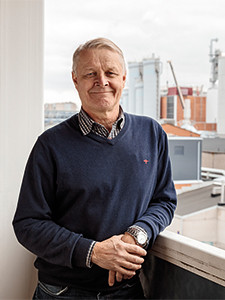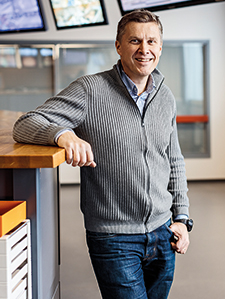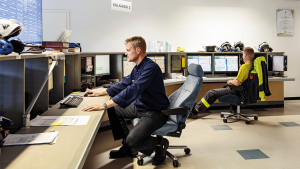Trucks wait for their loads at one end of the mill area, while forklifts carry neatly wrapped white pulp bales from the warehouse. Some carry the red label ‘UPM Betula’, others the blue label ‘UPM Conifer’. The bales contain the raw material for packaging, speciality paper, magazine and fine paper manufacturers. Most of the pulp manufactured at the plant has already been delivered to UPM’s own paper mill, where two paper machines turn it into fine paper.
We are in Kuusankoski in southeast Finland, at the heart of the Kymi pulp and paper mill. The 200-hectare integrated mill site is like a town within a town. The site has streets with real names such as ‘Fibre Avenue’, ‘Wood Chip Road’ and ‘Sheet Street’. Odourless columns of white steam rise into the blue sky from the chimneys of the clean, orderly site.
Here, on the shores of the Kymi River, overlooking miles of coniferous forests, wood is turned into pulp and pulp into paper.
Pulp demand on the rise
We start our tour at the General Manager’s office, where Markku Laaksonen, lists the benefits of the investment. Firstly, annual pulp production volume is set to increase from 530,000 to 700,000 tonnes. Secondly, the pulp is easier to grind, which will improve its quality. Thirdly, the mill is even more energy-efficient than before. The most important benefit is that the mill can now maintain a faster pace of pulp production, because the new drying machine can dry pulp at a much quicker rate than the old one.

Markku Laaksonen
With the investment completed on schedule as planned, the mill now produces more bleached birch and softwood pulp than ever before. This is a welcome improvement, since recycled paper is in short supply and there is high demand for pulp around the world. A growing volume of pulp is used to manufacture tissue paper and packaging paper, for which demand is increasing as online trading continues to grow. The growing middle class in China furthermore uses pulp in their household and hygiene products as well as in their printing and office paper.
Pulp is in fact a high-tech product of the future that can be used as a raw material in an astonishing array of products from ice cream and ketchup to anti-caking agents. It can serve as a substitute for cotton in clothing and for plastic in packaging materials. Small wonder, then, that the General Manager looks to the future with optimism, and his enthusiasm has rubbed off on the mill workers too: pulp is clearly back in business.
Expanded debarking plant
Next we don our personal protective equipment and head to the debarking plant. Normally the noisiest part of the integrated mill site, the debarking plant is silent today because of a shutdown.
The quality assurance process begins far away from the mill, in the forest, with the expert wood buyer who selects the logs. They mustn’t be too thin or rotten, and they mustn’t be allowed to rot by keeping them on the roadside or in a warehouse for too long.
The pulp mill’s investments are visible over an extensive area. The increasing demand for wood has sped up harvesting, which in turn brings more money to forest owners.
Modernised softwood fibre line
Energy efficiency has improved considerably. The mill self-generates higher volumes of heat and electricity, says Matti Tikka at the chemical recovery plant.We leave the debarking plant and head for the next improved site, the fibre line. A traffic sign points us in the right direction. We pass a huge white liquor tank to reach the control room, where we find several line operators closely analysing complex charts on their monitors.

These charts tell them how much chlorine dioxide is being used, for example. This is an issue that is especially important to departmental supervisor Mika Hohti. Apparently, consumption has decreased, which seems like good news.
Another improvement is that branches are efficiently sorted and separated, which reduces the amount of rejects and impurities and improves output. In addition to the modernisation of the fibre line, the third significant improvement made at the plant concerns energy efficiency, as explained by operations manager Matti Tikka at the chemical recovery plant.

Supervisor Mika Hohti monitors chlorine dioxide consumption. Bleacher Aki Korpela is on the right.
“Our energy utilisation is more efficient, and we are producing higher volumes of heat and energy. The mill’s self-sufficiency rate in terms of energy production has increased to more than 85%,” Tikka says. More heat is generated because more black liquor is combusted in the recovery boiler. The excess heat is sold to the district heating network. The heat and the ‘green electricity’ produced from renewable raw materials support the Group’s sustainability-based business.
There is only one final place to visit: the drying machine. We walk another short distance to reach the most expensive investment, which is located on the paper mill side, on the site where paper machine no. 7 used to be before it was dismantled years ago.
Efficient drying machine
This time we enter a control room that is chock-full of bustling people. We watch the monitors and see how the pulp sheets move along the packaging line towards robot claws. Bales ready for export are neatly packaged with wrapping and wire. Those without wrapping will be transported within Finland.
There was a clear need for a new drying machine, as the old one was already more than 50 years old and is currently being dismantled. “The pulp mill can now operate at full capacity even if the paper mill is at a standstill. Production had to be slowed down before, but now we are able to even out the consumption,” explains operating engineer Jukka Flinkman.
The day draws to an end. The evening shift takes over from the morning shift. The pulp bubbles away, and the paper machines roar. All is well at the Kymi integrated mill site.
Helen Partti
